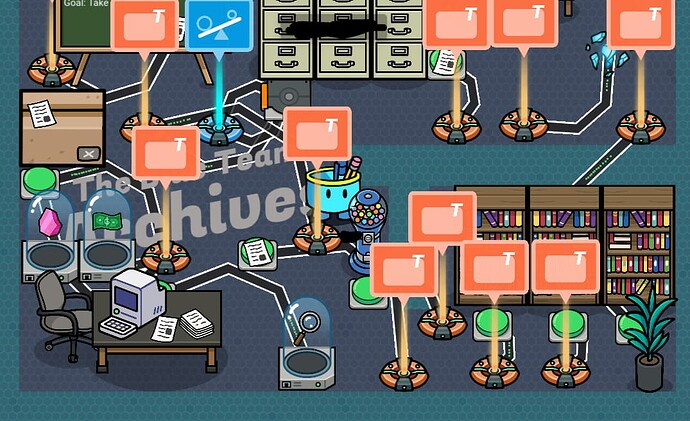< previous
next >
Yes, I am doing it again. If you’ve read it before, then I’ve covered most of the surface and shallow-end stuff. Time for deep-end stuff!
LAYERS!!!
As Shrek said, LAYERS!!! Not a very “secret” thing, but did you know that you can make a staircase using layers (just use terrain on different layers)? Also, you can make a large stack of plates using layers, stack props, etc.
Also, here is a guide on how to make floors (and a better staircase).
This is here because part 1 didn’t have it.
Channels and Wires
If you need a lot of wires, use channels because wires are 10 memory each. And here’s a picture of my dilemma:
See how messy it is? Wires can get messy, and with enough, you can’t tell which is which.
Puzzle Maps
A puzzle map is a term I kind of “invented,” and it’s where you have a lot of puzzles for the player(s) to solve. These are preferably singleplayer, and should be complicated.
Now, if you’re making one, remember that it needs to be challenging so people don’t start speedrunning out of boredom. Also take note that the puzzles should get progressively harder so it’s harder for people to do fast. Take that, speedrunners! Then again, those who want to do it could memorize the obstacles, but that’s cruel at this point.
Interactive Features Part 2
If you’ve read the previous one, you’d know that I covered a lot of interactive features. However, there’s more!
- One Way Out is cool, but you know what’s cooler? Lore! And you know what’s cooler than lore? Wait for it (drumroll please)… useful props! Props are for decoration, but you can make a functional 3D printer (finally), readable notes (using the ship log one because it applies to everything, including any prop, and because it’s the original), etc. Anyways, you can make the internal monologue from One Way Out [insert guide link here], One Way Out-style barriers, [insert more here]
Credits:
“LAYERS!!!” Credits:
Blizzy’s post:
“Interactive Features Part 2” Credits:
505Correct’s post:
Haiasi’s post:
Hope you enjoyed reading, and that’s all for part 2.
